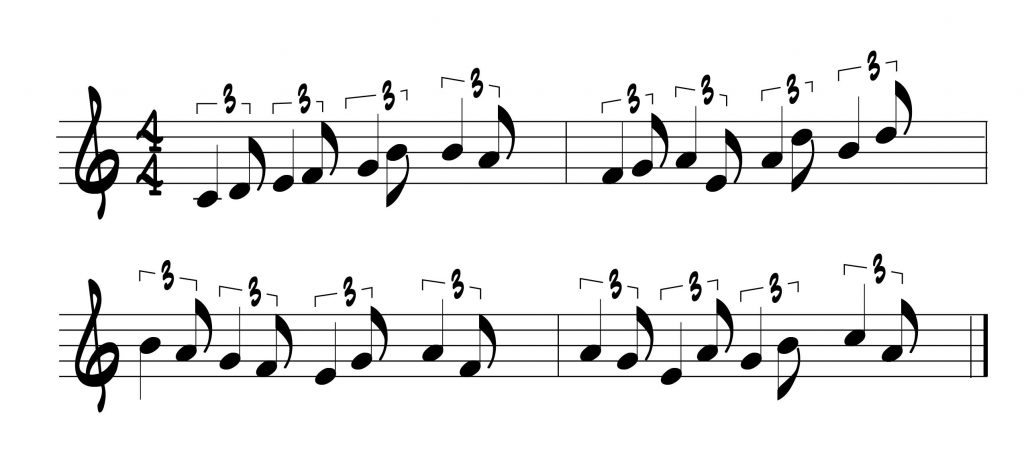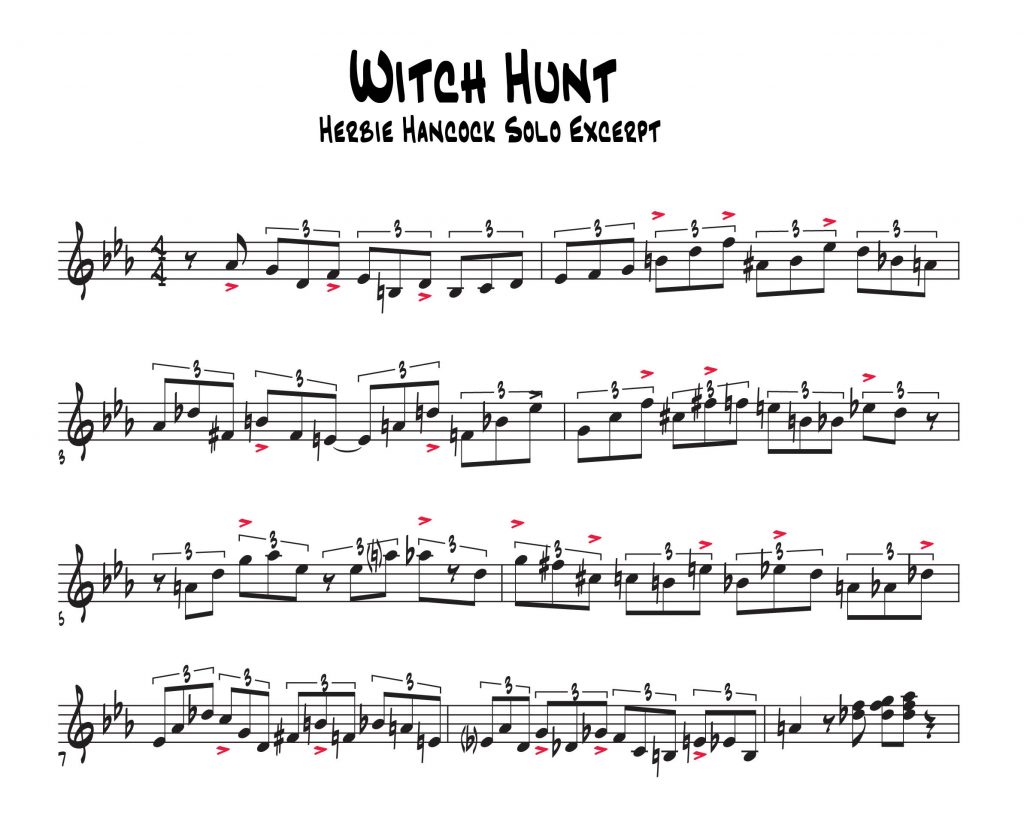
The Benefits of the Ear to Instrument Connection
I recently watched a video performance by the amazing classical pianist Yuja Chang. I’ve seen her memorizing motion and heard her virtuosic playing before, but something hit me after seeing
Categories:
Categories:
I enjoy writing about this topic. After all, it don’t mean a thing if it ain’t got that swing!
I ask myself the question: why do some jazz players swing and others don’t? While everyone’s flavor of rhythm and swing is different, why don’t more musicians swing–really swing?
Let’s start at the top: what is swing?
The very first result in Google for “what does the musical term swing mean in jazz?” is the following:
“Swing refers to a specific way of interpreting rhythm where eight (sic) notes are played like triplets to create a galloping sound.” – landr.com
That is a terrible definition of swing, but showing up first in Google tells you it is the most popular. Imagine young players trying to discover what swing is, and this is “all-knowing” Google’s answer!
Putting aside that I have no idea what a “galloping sound” is apart from marches, we seem stuck with the triplet definition of swing. That’s the idea that swing arises from playing the first and third eighth note of an eighth note triple. DAA da DAA da DAA da DAA and so on…
That is very unhelpful for players starting out learning jazz trying to understand the language.
I propose a much better definition that has nothing to do with triplets:
Swing is a particular phrasing of emotionally infectious rhythms and musical lines played using syncopation and emphasis. The feel of the music is often behind the beat, and it encourages a personal rhythmic freedom in pursuit of a groove.
The idea that triplets create swing is very popular, and at slow tempos it works. But pretty quickly with most tempos, triplets don’t result in swing.

Listen to me play the first part of the tune Teach Me Tonight. The tempo is very inviting for the slow triplet feel. Listen to the tri-po-let, tri-po-let subdivisions of the beat against my rhythms. Hear the bass and drums accenting the triplet along the way.
The purpose of this post is not to convince you to sound like me (“swing like Mike”). If you’ve read anything by me, you know that trying to sound like someone else is a waste of your time. I’m playing these few examples to provide some contrast on order to demonstrate specific aspects of swing that you will hopefully hear and apply to your own playing. Who better than me to play the foil in these examples!
With that said, next let me play Bb blues at a faster tempo, again leaning on the triplet feel. Does it swing like Teach Me Tonight? What’s the difference? What else is kind of sucks about the trombone playing in this example?
A few things about it suck. But first, let me say that was interesting trying to force a triplet feel into my playing while recording at this tempo. The more I forced that tri-po-let feel, the less hip my ideas became. I just couldn’t play interesting content, and when I did, the stiffness dissipated. I recorded a bunch of takes trying to get something recorded that would demonstrate stiff non-swing playing.
Notice that there is very little rhythmic variety in what I played. I’m basically running scales. There’s very little variety in the phrasing: DAA da DAA da DAA da DAA… Very little variety in the note lengths. One thing I worked hard to suppress were the note accents. I was forcing that flat triplet feel. Dare I say my playing was ‘galloping?’
Now that we know that is not swing…
I think of it as three musical attributes working together…
1. Note emphasis that creates syncopation or rhythmic interest At faster tempos, the note accents propel the lines forward and give them groove instead of a stiff triplet time subdivision feel or just straight eighth or quarter notes. Emphasis is not only on the weak parts of the beat but really anywhere that gives the line the motion of swing.
I remember in my trombone lessons in college playing my classical etude studies for my teacher. He would constantly say, “Stop swinging the lines!” I didn’t hear what he was talking about. It wasn’t about any triplet rhythmic placement of notes, it was the offbeat accents that he heard (and hated).
Let me demonstrate an exercise you can play in order to strengthen your flexibility for note emphasis. I’ll start by playing straight eighth notes, and then morph into adding emphasis and dynamics into the notes. Same Bb note and eighth note rhythm but varying note emphasis, dynamics, and sound. I’m not trying to swing, but instead, exercise my ability to vary the emphasis and character of notes as I improvise.
Make sure to record yourself as you play this. Don’t use a metronome since perfect time is not the point. See how you do with this playing faster and slower. How smoothly can you move in and out of dynamic emphasis?
2. Syncopation Going hand in hand with note emphasis, syncopation is the opposite of stressing the downbeat. Emphasized downbeats are for marching bands. Syncopation emphasizes the notes in the weaker parts of beats and where melodic lines begin and end. If you hear yourself consistently starting lines right on beat one or repeatedly emphasizing the downbeat, that may be the reason you don’t swing.
3. Melodic ideas I mentioned above that as I forced that tri-po-let feel into my time, the lines became basically scales. Great swing gives rise to hip melodic musical lines. At least for me, it’s hard to swing while improvising dull lines (limited range, little rhythmic variety, narrow dynamics, etc.)
Skilled improvisation is an interplay between melody and rhythm. Good jazz melodies demand syncopation. Without syncopation in jazz, melody becomes dull.
All three of these attributes of swing are connected. Good jazz swing comes from syncopated melodic lines punctuated by an emphasis of certain notes and rhythms that move the music forward. In jazz, no two notes are equal. Each note has its own subtle place, dynamic, and personality within the complete musical story you tell.
Let’s listen to a great example of combining all three attributes into a solo. Here’s the recording of Wayne Shorter, Ron Carter, Freddie Hubbard, Elvin Jones, and Herbie Hancock playing Wayne’s great tune, “Witch Hunt”, off of the Speak No Evil album.
Everyone is deeply swinging on this tune. Listen to Herbie’s solo. I’ve notated a bit of his solo below the track that begins at time 5:53. I’ve inserted accent marks where Herbie gives a little more emphasis to the note. Great players like Herbie play with a continuum of emphasis, not just loud and soft, but my notation at least gives you a sense of the variety and syncopation within Herbie’s lines.
From a compositional standpoint, Herbie starts the beginning of the solo with a couple of short triplet licks, and develops the triplet as an important rhythmic motif within the solo. This section at 5:53 in the track is where Herbie first expands on the triplet figure. Because of the flow and emphasis he gives notes throughout this section, you almost forget he’s playing triplets.
Notice the angularity and beauty of his lines, the harmonic exploration, the syncopation and flow through bar lines and strong beats, and a result, his great swing. One characteristic of swing that Herbie exemplifies is forward movement. Everything he plays propels beautiful motion. He’s taking us on a feel-good ride. He swings.

Imagine if Herbie accented only the first notes of each triplet. DA da da, DA da da, DA da da… It would sound terrible. There would be no syncopation. It would be predictable and boring.
Listen to your own playing. Starting your phrases frequently on one or accenting only the strong parts of the beat or rhythm may be a sign that you are not swinging.
Reading this post will give you a kind of mechanical outline, but it won’t instantly turn you into a swinging mofo. Sorry. For that, you must listen and get the feel of swing in your bones. Feel it when you walk, talk, and move.
I hope this also helps you more easily identify why one player swings and another doesn’t, which will allow you to more objectively assess your own rhythmic approach to jazz (your swing).
The most effective way to develop swing is to listen to good players and to a variety of them, and do so over years and years. And don’t listen only to jazz, by the way. Other styles including funk and hiphop have their own version of swing. What they all have in common is an infectious human rhythmic flow that feels good and gets you bopping your head and tapping your foot.
Here are a few that do that for me on vocals and different instruments…
Let’s start with Oscar Peterson. Listen to how he plays the melody. Listen to emphasis he gives to certain notes over others.
Another deeply swinging piano player is Richie Beirach. This is from his album called Trust with Jack DeJohnette and Dave Holland. Richie has a great drive and intensity to his swing. Hear also how engaged Jack and Dave are. Different from Oscar, this is a trio in which all three are crafting the swing and the tremendous energy together.
Here is McCoy Tyner and Trane each demonstrating their flavors of swing. Again, especially with Elvin, this is group energy.
Freddie can’t help but swing over this rhythm section of McCoy Tyner, Art Davis, and Elvin Jones.
George Benson made his money in pop and funk, but he could swing jazz as well as anyone. Here he is with Herbie Hancock.
Here’s the great Frank Rosolino swinging hard with his friend trumpeter Conte Condoli.
One of the great male jazz singers and scatters, Eddie Jefferson swings with such a great feel-good vibe. You can’t help but smile when you hear Eddie sing.
And here’s the great Ella Fitzgerald scatting a classic solo. This is swing!
I mentioned above that other styles beside jazz can swing. Here’s a great Youtube track from an Italian TV show featuring James Brown. Without hearing him, you can just see James and feel his groove.
And while we’re talking about swing in the context of other styles, he’s something that swings from pop music. And how could it not with players like Randy and Michael Brecker, Larry Carlton, Anthony Jackson, and Hugh McCracken!
I’ll leave you with something that has always been a favorite of mine. Call this Jazz-Rap. It was made in the early 90s as sampling was becoming more mainstream. The beginning announcement was made by Pee Wee Marquette and is taken from the Blue Note album “A Night at Birdland Vol. 1” by the the Art Blakey Quintet. The trumpet solo is by Gerald Presencer.

Trombonist, author, marketer, & tech guy
Share this post…

I recently watched a video performance by the amazing classical pianist Yuja Chang. I’ve seen her memorizing motion and heard her virtuosic playing before, but something hit me after seeing

I have created a AI chatbot called Jazz Master Chat that draws from 75 hours of interviews from my Jazz Master Summit event a couple of years ago. I interviewed

What is jazz improvisation? Let’s first define what I mean by jazz improvisation. Jazz improvisation is a spontaneous conversation, but instead of words, we use notes. Look at two possible

My recently turned 18 year old son is a passionate photographer He 8217 s got himself a little business

A couple weeks ago I sent Richie Beirach a YouTube clip from the movie Whiplash as a bit of

I originally meant to write this as a reply to a comment Richie Beirach wrote on my blog But

Tools for helping musicians at all levels learn about jazz and play to their full capability.
Web design and marketing by:
Michael Lake @JazzDigitalMarketing.com
This is just a fake book example for the type of website I can build for you. Just trying to use a little humor here!
8 thoughts on “How to put more swing into your playing”
Another great blog on a difficult and slippery subject. You’ve provided one of the best explanations of swing I have ever read. Good musical examples too. Thanks for including my BOSTON HARRY TRIO TRACK.
One thing I might add: when you are really swinging, it’s usually WITH OTHER PLAYERS!! Of course you can swing by yourself and you MUST before you do it with others, but the real JOY is when you are in there with a great bass and drum team JUST FLYING !!
My body instantly feels swing – and I can’t keep my feet still.
Great informative blog, Mike!
Thank you for putting this together – so many areas in music that swing.
Your introductory remarks about “doing the work” resonate. Unfortunately, many excellent players who are also purveyors of learning music (any music or instrument) USUALLY entice the uninitiated with promises of success without emphasizing that it will require years of hard work.
Insightful article, thanks.
I’ve found that vocalization/scat singing is a very good way to develop a “swinging” rhythmic concept. Singing Miles’ solo on “Freddie Freeloader” is a good starting point. I have my drum students do this. It is also a good way for drummers to develop comping skills.
In sessions with student instrumentalists, I’ve found that the drummer is often regarded simply as a time-keeper. The instrumentalists invariably listen to the parts of the kit that are repetitive; e.g. 2/4 hi-hat or seemingly repetitive ride pattern. They listen to the drum set as though it is a metronome and miss the syncopated comping figures that are an intrinsic part of the “swing”, not to mention rhythmic improvisation. In so ways, an important and vital aspect of learning how to “swing” is learning how to listen to the rhythm section. And to listen, one must initially learn to leave space in their solos to give themselves the chance to listen to the rhythm section. It takes awhile for a player to develop the security and maturity to understand that one can be just as creative with silence as with sound.
Yes, I like the idea of singing. Removing the instrument is often helpful in getting to the root of a problem or in developing aspects of a skill. I have a post coming out next week on exactly that. Thanks Ed!
Mike Lake. Bob Washut here. Long time, no see (40+ years)! Bobby Shew forwarded this link and I recognized you immediately. Nice work! Sounds like you’re doing really good things. All best.
Thank you for this very nice article and discussion.
Readers might like this demo of New Orleans rhythm shown here:
https://www.youtube.com/watch?v=geze6A1p3Ww
This video is helpful because the rhythm is played slowly, so one is able to get a better sense of the swing beat.
Are there any “musical learning coaches” (sic teachers) who from day one teach listening and swing, starting from the very first note learned to play on the instrument? Then incorporating the second note, adding a new pattern combining the 2 notes. I’ve always had a hard time with the 1st level elementary method books in schools.